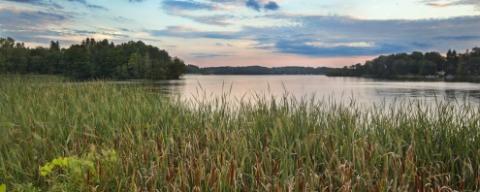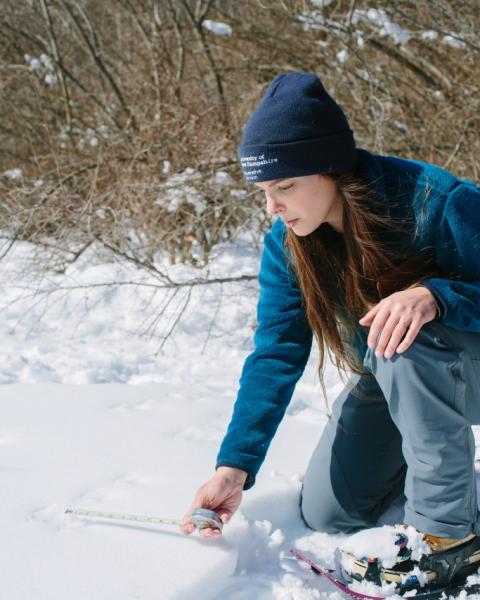Marsh and shrub wetlands include a variety of wetland types, each with different vegetation, but with one thing in common: the soils in them are wet most of the year.
Marsh and shrub wetlands are rich habitats that provide a number of critical ecosystem functions such as flood control, pollutant filtration, erosion control, and wildlife habitat. Marshes are important for fish and amphibian breeding and for waterfowl, and they connect people to habitat through hunting, fishing, tourism, and recreation. Shrub wetlands may seem inhospitable to people, but their dense thickets provide reliable cover from predators for many wildlife species.
High-quality marsh & shrub wetlands are found in all parts of New Hampshire, with higher concentrations in Rockingham and Belknap Counties. Lake Umbagog, Great Bay, and the Connecticut River Valley have been identified as particularly important areas for waterfowl habtat due to their extensive high-quality wetlands. In assessing the quality of a marsh or shrub wetland, look for:
- isolation from development: at least 1000 feet from houses, roads, or recreational trails
- surrounded by intact vegetation
- in remote areas where beaver dams won't interfere with humans
Types of Marsh & Shrub Wetlands
Marsh & shrub wetlands fit into three groups, identified by their vegetation:
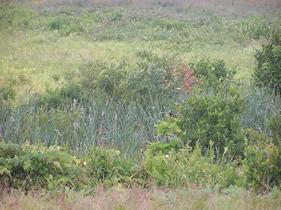
Wet Meadows
Wet meadows are filled with sedges and grasses. Wet meadows may not be flooded all year, but they are wet for long periods during spring and summer. They provide a rich habitat for such critical species as ribbon snake, spotted turtle and northern harrier.

Marsh Habitat
Marshes contain plants that grow out of water, but whose roots are wet, such as cattails, pickerelweed, and water lilies. Blanding’s turtles, American black duck and red-winged blackbirds rely on marsh habitat for their feeding and lifecycles.

Shrub Wetlands
Shrub wetlands are thickets of shrubs and young trees growing out of wet soils, and they often flood in the spring. Spotted turtles, Canada warblers, New England cottontail, and American woodcock all use shrub wetlands for food, cover, or breeding habitat.
Where are Marsh & Shrub Wetlands in New Hampshire?
High-quality marsh and shrub wetlands are found in all parts of the state, with higher concentrations in Rockingham and Belknap Counties. Lake Umbagog, Great Bay, and the Connecticut River Valley have been identified as particularly important areas for waterfowl habitat, due to their extensive high-quality marsh and shrub wetlands.
Beaver dammed areas showcase different wetland types over time and as a result, are very valuable as habitat for other wildlife species. A beaver dam site will cycle from ponded water (marsh) to abandoned/drained area (wet meadow), and re-growth (shrub wetland).
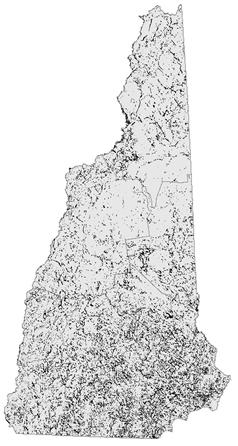
The highest-quality wetlands are typically defined as being:
- at least 1000 feet from houses, roads or recreational trails
- surrounded by intact vegetation
- in remote areas where beaver dams don’t affect humans
The map at right was created using NH Wildlife Action Plan mapping data. To learn more, click here (connects to NH Fish & Game website on using habitat maps)
Understanding Threats to Marsh & Shrub Wetlands
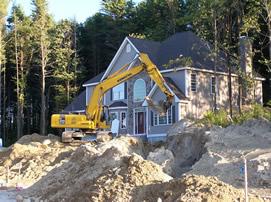
Development
Historically, New Hampshire has lost fewer wetlands to development than many other states. However, we also have little direct protection for these important parts of our ecosystem. As southern New Hampshire faces increasing development pressure, wetlands and their surrounding uplands are at risk. Construction setbacks aren’t always required around wetlands in NH (except septic systems) and wetlands are routinely filled and damaged by driveway and road crossings. Loss of upland habitat, pollution, salt runoff from roads, and destruction of beaver dams (because of their proximity to backyards) all have a detrimental effect on our marsh and shrub wetland communities.
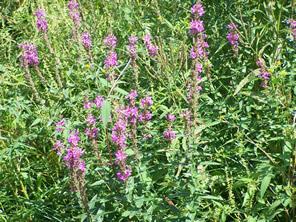
Invasive Plants
Invasive plants such as purple loosestrife, common reed (Phragmites), and Japanese knotweed threaten the diversity of plants in marshes, and several woody plants such as glossy buckthorn are a problem in shrub wetlands. Invasive plants take over native vegetation and offer less-valuable habitat and food sources for many species of wildlife.
Climate Vulnerabilities for Marsh & Shrub Wetlands
- Changes in precipitation patterns will lead to changes in duration and seasonality of flooding. These changes will likely favor generalist species that can tolerate a broader range of hydrologic conditions, and lead to an overall loss of plant species diversity.
- As temperatures increase, invasive species currently present could become more abundant, and new invasive species could arrive.
Click here for the Freshwater Marsh Climate Assessment, a section of the Ecosystems and Wildlife Climate Change Adaptation Plan (2013), an Amendment to the NH Wildlife Action Plan
Wildlife Found in Marsh & Shrub Wetlands
The species listed here are closely associated with marsh & shrub wetlands, but many other wildlife species will use these wetlands at some time of the year for breeding or foraging. Species of conservation concern--those wildlife species identified in the NH Wildlife Action Plan as having the greatest need of conservation--appear in bold typeface with links to their species profile from the Plan.
NH Fish & Game publishes a website about reptiles & amphibians in NH with identification photos for all species.
- American black duck
- American bittern
- American woodcock
- Blanding's turtle**
- Common moorhen
- Eastern red bat
- Great blue heron
- Green darner dragonfly
- Least bittern
- Mink
- Muskrat
- New England cottontail**
- Northern harrier**
- Northern leopard frog
- Osprey
- Pied-billed grebe*
- Red-winged blackbird
- Ringed bog
- Haunter dragonfly**
- Rusty blackbird
- Sedge wren**
- Silver-haired bat
- Spotted turtle*
- Spring peeper
- Virgina rail
* state-threatened species
**state-endangered species
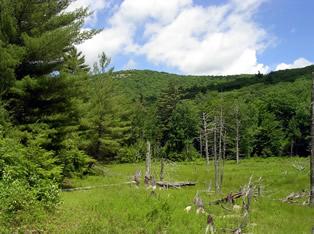
Stewardship Guidelines for Marsh & Shrub Wetlands
-
Focus land conservation around beaver flowages across the landscape, not just around present-day beaver impoundments. Doing so allows the natural abandonment and establishment of new dams. Conserving only the present-day impoundments while allowing development and road-building near abandoned dams forever precludes the natural succession of those abandoned beaver ponds– from newly flooded sites, to stagnant ponds, to open meadows, and back to reforested landscapes.
- Maintain beaver dams and flowages and use beaver dam water control devices to maintain a consistent water level (important for protecting property or roads).
Locate new roads and development where they are unlikely to be flooded by potential beaver dam sites.
- For land conservation efforts to successfully protect wetlands wildlife, uplands surrounding wetlands need to be protected as well. A 300 foot buffer of upland, unimpacted by development (no paved roads, buildings, etc.) protects water resources and habitat for many species. However, to truly isolate the wetland from negative development impacts, this buffer may have to extend 1000 feet or more from the wetland edge.
- Regenerate and promote growth of aspen and other hardwoods in small patchesor strips along slow streams and rivers to enhance the food supply for beavers. Mallards and black ducks will benefit, as they nest on open ground around waterbodies.
- New Hampshire Fish and Game tracks sightings of rare reptiles and amphibians. Report any sightings to the NH Reptile and Amphibian Reporting Program (click and scroll down to learn more about reporting sightings).
- Maintain habitat structures such as dead standing trees and overhanging vegetation in the water to provide cover for wildlife; keep downed logs as basking sites for turtles.
- Leave and protect standing dead trees as habitat for heron and osprey nesting, as roosting sites for bats, and as cavity nesting sites for a variety of other birds and mammals.
- Focus wetland restoration efforts on restoring flooding to marshes. Bogs and forested wetlands (such as red-maple swamps) aren’t easily re-created after damage to their vegetation or after changes in their flooding patterns.
- Don’t use heavy machinery within wetland soils to avoid negative impacts on animals or disruption of the wetland’s flooding pattern.
- Where feasible, maintain open, sunny areas with little vegetation (or sandy areas) adjacent to or near marshes for turtle nesting.
- Maintain brush and other woody material in and around wetlands to provide cover for small mammals, amphibians, and reptiles.
- Limit recreational access (either completely or with as few access points as possible), as even low levels of human disturbance can disrupt marsh wildlife. Where access is allowed, avoid trampling existing aquatic vegetation. ATVs shouldn’t be allowed in or around wetlands.
- Where human-built dams are present, avoid drawing down water levels in fall and winter, as this exposes dispersing and hibernating amphibians and reptiles to colder temperatures.
Additional Resources on Marsh & Shrub Wetlands
- Wildlife Action Plan Profile for Marsh & Shrub Wetlands - including information about the condition and location of this habitat, the threats facing this habitat, and conservation actions recommended by biologists to protect vernal pools in New Hampshire.
- Wetlands Assessment - Click here to download (or order) the UNH Cooperative Extension publication, "The Importance of Hydroperiod in Wetlands Assessment," a technical publication for wetland scientists and public decision-makers interested in assessing the habitat value of various wetlands (at left).
- Learn more about Reptiles & Amphibians in New Hampshire - Link to the NH Fish & Game Department's "Reptile & Amphibian Reporting Program," and learn about identifying species, learning frog calls, and how you can help conserve New Hampshire's snakes, frogs, salamanders, and toads.
- NH Wetlands Laws & Regulations - link to NH Department of Environmental Services Wetlands Bureau
Photo Credits on this page: Malin Ely Clyde; Mike Marchand, NH Fish & Game.
Research for this webpage and accompanying Habitat Stewardship brochures was conducted by UNH Cooperative Extension staff with support from the Sustainable Forestry Initiative and NH Fish & Game
